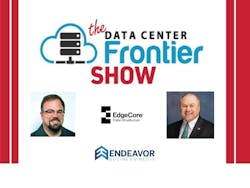EdgeCore CEO Lee Kestler on Density, Energy, and the Purpose-Built Future of AI Data Centers
Speaking on the latest episode of the Data Center Frontier Show, EdgeCore Digital Infrastructure CEO Lee Kestler outlined how his company is navigating the accelerating demands of hyperscale and AI workloads, grounded in what he called a “sobriety check” for a sector under pressure to deliver faster and denser than ever before.
“This industry right now is at probably an unprecedented level of enthusiasm and anxiety,” Kestler said. “The enthusiasm is around all the opportunities that technical evolution allows us through Internet data centers. The deployment of artificial intelligence today now is giving us that new first inning, so to speak — like we were with Cloud maybe 10 or 12 years ago.”
But with that opportunity, he added, comes complexity that can’t be solved overnight.
“This is not a video game,” Kestler cautioned. “This stuff takes a long time to coordinate. That takes time, intellectual property, collaboration — and of course, trial and error.”
Design for Density: A Rebrand with Purpose
EdgeCore rebranded in 2023 with the theme of “Design for Density,” reflecting a strategic emphasis on large-scale, air-cooled campuses with 300+ MVA capacity, primed for closed-loop liquid cooling when customer demand warrants.
“We rebranded ourselves… with the expectation that 300 MVA-plus campuses, multiple buildings with density and air-cooled chilling systems, and obviously the ability to use closed-loop liquid cooling in the future were the forecast for what our basis of design should look like.”
EdgeCore’s discipline comes from continual listening: to hyperscale clients, to long-term partners like Holder Construction and Vertiv, and to the evolving needs of their regions.
“We’re not trying to be the innovator creative engineering firm. We are out there delivering and executing to what we think the customer wants.”
Liquid Cooling: A Real-Time Learning Curve
While EdgeCore is preparing for the rise of liquid cooling, Kestler doesn’t see it as a binary shift. The vast majority of workloads today are still CPU-driven, and air cooling remains dominant.
“Nobody knows for sure exactly what the liquid cooling solution is going to be in an operational setting,” he said.
EdgeCore is collaborating with Vertiv to ready facilities for future adoption, but air remains the go-to for now.
“It’s not as competitive right now as it is contemplative,” Kestler said. “People are collaborating to figure out what works.”
Energy, Utilities, and Long-Term Sustainability
Kestler’s power perspective is deeply informed by past work at Oak Ridge National Lab and NextEra Energy.
“I’m a big proponent of carbon mitigation,” he said. “But I also take a sobering approach to how we integrate it.”
EdgeCore avoids evaporative cooling and has made a no-water-use commitment, beginning with their campus in Mesa, AZ. The company also insources operations staff to gain control over power delivery and efficiency.
Kestler spends significant time engaging utilities on long-term planning.
“We’re not here to insult utility subject matter experts. We’re here to help them,” he said.
Behind-the-Meter and SMR Power: Strategic Patience
On behind-the-meter generation and small modular reactors (SMRs), Kestler is cautiously optimistic.
“Whether it’s 2035 or 2032, I don’t know — and I don’t think they know — but I believe they’ll get there.”
EdgeCore’s approach is to remain aligned with utilities, enabling their investment through long-term load predictability rather than going fully off-grid.
“There is a stage here where science has to lead. It can’t be wishful thinking.”
Partnerships, Predictability, and the EdgeCore 2.0 Model
With lead investor Partners Group, EdgeCore has built a delivery model focused on risk mitigation and trust. That includes:
- GC partnership with Holder Construction.
- Supply alignment with Vertiv.
- Community integration through leaders like Bill Jabjiniak (former Mesa EDC).
“Our partnerships are based on capital leads. We don’t want to necessarily build everything ourselves.”
Campus siting also prioritizes aesthetics and local feedback, including mural programs, noise modeling, and wind assessments.
Density, Logistics, and the Limits of Design
As racks climb from 25kW to 95kW+, Kestler says logistical planning and density management now shape architectural strategy.
“We can make the exterior better. But function drives the materials. You need resilience, rooftop support, and load capacity.”
Market Focus: Arizona, Virginia, and the Expanding West
As we wrapped up our conversation, I brought the discussion back to EdgeCore’s data center development footprint — and asked CEO Lee Kestler for a snapshot of the company’s regional focus going forward.
“We’re very deliberate, intentional,” Kestler said. “We want to be very good in a couple key places where we believe customers, when they look, are going to look for a handful of partners in each geography.”
Those key markets today are Virginia and Arizona, where EdgeCore is making massive investments in scalable, utility-aligned campuses.
“We’re going very, very big in Arizona and Virginia, and there are reasons for that,” he said. “You’ll hear another significant announcement before the end of June — the trend you’d expect from EdgeCore: large campuses, 300 MVA or bigger, with buildings growing to 72 megawatts and beyond.”
EdgeCore has already built out 108 megawatts and has a 144 MW design in its pipeline. That scale allows EdgeCore to mitigate supply chain and coordination risk — a key differentiator in a market where customers are seeking predictable delivery and execution.
“We take properties from where they are today to a stage where the customer can see a light into the horizon,” Kestler explained. “And that’s where we need to be experts.”
With Phoenix leading the way, I asked whether nearby markets like Salt Lake City and Reno could follow suit. Kestler said they’re already well-positioned in Reno, with land held since 2018–2019, and remain “very positive” on Salt Lake.
“Michael Shaw spends a good amount of time looking around that region,” he noted.
He also reiterated EdgeCore’s strong preference for Salt River Project (SRP) territory in the Phoenix metro over APS, citing deep incumbency and operational momentum. That includes a recent land acquisition adjacent to EdgeCore’s existing operational site off Eastmark Parkway and Elliott Road.
Beyond the West, he acknowledged hot markets like Ohio and opportunities in the Southeast — but emphasized that EdgeCore’s focus will remain tight.
“The sky is the limit,” Kestler said. “But you have to be very focused and understand the capital leads. And so we’ve picked Arizona and Virginia for today. You may see a few other surprises.”
The Most Misunderstood Thing About Data Centers
To close our conversation, Kestler shared what he believes is most misunderstood about the industry: its contributions to local communities.
“We’re not coming in to consume. We’re giving — tax revenue, jobs, IP. The biggest misnomer is that there are no jobs.”
At EdgeCore’s Mesa campus alone, 1,600 workers have been onsite for 19 months, with years of construction still ahead.
“They’re buying homes, building careers. That’s the part people need to understand. That’s the value we’re creating.”
At Data Center Frontier, we talk the industry talk and walk the industry walk. In that spirit, DCF Staff members may occasionally use AI tools to assist with content. Elements of this article were created with help from OpenAI's GPT4.
Keep pace with the fast-moving world of data centers and cloud computing by connecting with Data Center Frontier on LinkedIn, following us on X/Twitter and Facebook, as well as on BlueSky, and signing up for our weekly newsletters using the form below.
About the Author
Matt Vincent
A B2B technology journalist and editor with more than two decades of experience, Matt Vincent is Editor in Chief of Data Center Frontier.



